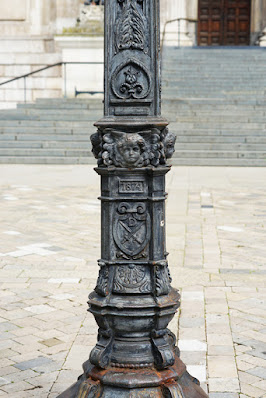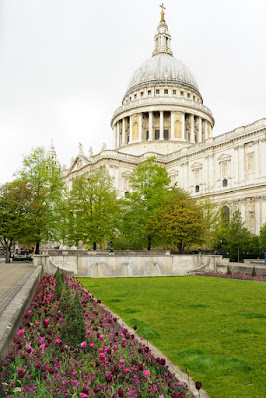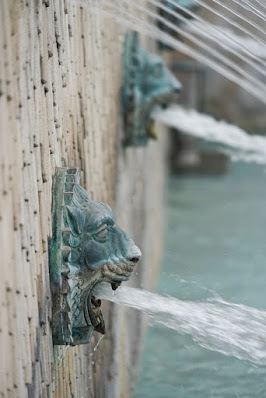The pandemic has spawned a small photography genre: London looking empty. I hadn't contributed much to it as I've hardly been into central London in the last year, but a recent library trip was a good excuse for a walk which took me past St Paul's Cathedral. For the first time, I saw its steps without people!
A
more constant, but nonetheless interesting, presence are the
streetlamps in front of the Cathedral. With space and leisure for a
closer look, we can see that they are dated 1874 and rich in details.
The cast iron posts include the Dean and Chapter's coat of arms, with
cherubs above.
In fact, these lamp posts are Grade-II listed in their own right. They were designed in 1874 by the Cathedral Surveyor, architect FC Penrose, as part of wider improvements to the space in front of the cathedral's west end. Although nearby Holborn Viaduct would get electric lighting four years later, these were gas lamps. (They have since been converted to electricity.)
While this area is decorated with lamps and statutes, the south side of the cathedral has flower beds and fountains. A note of springtime to finish upon!






3 comments:
Thanks for another fine article. Victorian gas lamp standards are fascinating. There are several in Hyde Park where the top of the cast iron pillar houses a Blue Tits' nest, the small birds being just able to squeeze in between the gas pipe and the edge of the circular hole. In Carting Lane just off the Strand there is a lamp designed to burn off methane vented from the sewer beneath. The gas lamps on Primrose Hill, now sadly converted to electricity, have the monogram of the ruler cast into the pillar -- mostly V R of course, but there is one with W IV R, showing that it was installed between 1830 and 1837.
St Paul's Cathedral's location and architecture still look amazing, but the emptiness is haunting. It reminds me of Sicily after Mt Etna erupted. Hopefully normal life will return soon.
Hels, it was very strange - nice as it was to see St Paul's without the crowds (only two other visitors inside at the same time as me!), it was unnerving at the same time.
Thank you, Ralph - I know the Carting Lane lamp but not the Primrose Hill ones, I'll have to try to spot the W IV R one when I get a chance to visit!
Post a Comment